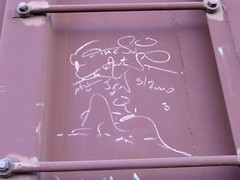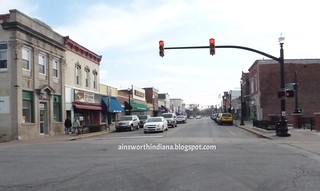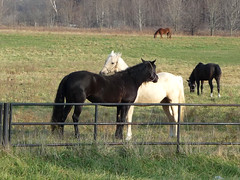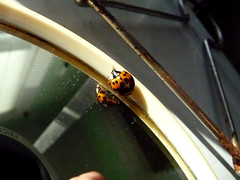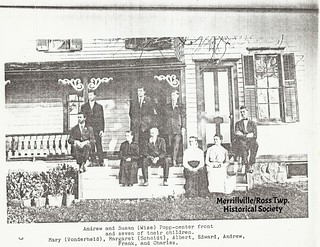 The Popp Family (click on image to enlarge)
The Popp Family (click on image to enlarge)
When I wasn't looking, Charles (pictured above) and Lucy Popp swept into Ainsworth and opened a grocery store. The first I ever heard of these two was when Lucy made it into
Along the Route for getting herself appointed
postmistress.
I know very little about Lucy because I can't find her maiden name. In 1933, after the birth of one of her children, her mother came down from Chicago to help out, but the newspaper reporting that visit fails to give the mother's name. And so, apart from Lucy's birth (March 23, 1901) and her not-quite-four years as postmistress, all I can say is that she married Charles Popp and bore his children. Indeed, that seems to be all I can say about most of the women of whom I speak in here, except Carrie Chester Raschka. My research is fairly superficial, dealing only with public records and newspapers, and those sources show women as someone's daughter, then someone's wife, then someone's mother, then someone's widow, and then they die. Newspapers speak of women as "Mrs. John Smith" or even just "Mrs. Smith." Women pay social visits, which are sometimes recorded, and they hold meetings of ladies' clubs; they occasionally perform in public musical recitals. A better writer and a deeper researcher might make a story from those activities.
The newspapers so far haven't given any hint of the less respectable things a woman might possibly get up to — not regarding these Ainsworth women, I mean. Other women in other places were involved in all sorts of scandalous things, and here I can't even get a woman arrested. Although — who knows? — maybe John Chester was taking the fall for Emma in that
bootlegging business.
Anyway, now that I've explained the androcentrism of this blog, let's get more androcentric and move on to Charles Popp.
He came from a relatively old local family. Both his father, Andreas, and his mother, Susannah (née Weis), were born in Lake County. Charles was born April 18, 1895, in Merrillville. (Take a look at Susannah Popp in the photograph above. She looks very good for having borne eight children, doesn't she? — and that's eight children who show up on the census. There may have been more.)
It was a farming family. The 1910 census finds Charles still at home on the farm, but within a few years, it seems, he'd had enough of farming. He went to work for the Grand Trunk Railroad as a pump man at the Lottaville station.
I had to go look up what a "pump man" does. Here's a job description circa 1918:
Description: The pump man must operate pumps and keep a constant water supply in tanks or troughs. He must be able to run any sort of small gasoline, electric, or steam pump. He should understand the firing and care of a small steam boiler.
Qualifications: The pump man should know enough about the machinery to keep it oiled and to report at once the need of necessary repairs.
Schooling: Common school.
So Charles was in charge of the pump that kept water in the Lottaville tank for passing Grand Trunk steam engines that might need it.
By 1920 he'd had enough of pumping. He moved to Gary and went to work in the steel mills. He lived in what must have been an interesting rooming house — ten roomers, four of them foreign-born, one a young woman, most of them steel workers, but also a railroad worker, a telephone company electrician, and a stenographer and a laborer in a tin-plate company.
I don't know when or how he and Lucy met, but they married sometime between the January 1920 census and 1923, when their first child was born.
At some point after 1920 Charles found he'd had enough of steel mills. By 1926 he was living in Ainsworth, running for 2nd Precinct Committeeman. He and Lucy had probably moved there to operate the grocery store. In 1927 Lucy was appointed postmistress.
Our favorite Enumerator in the 1930 census, Elizabeth L. Fredrick, places the couple and their two children on "Ainsworth Road," by which, as is evident from the other names listed, she meant State Road 51 — so the grocery store was at the intersection of Ainsworth Road and Ainsworth Road. I haven't found out yet what the present-day Ainsworth Road was called back then, other than the "
Old Sac Trail."
He may have been a pretty good shot, our Charles. We find a Charles Popp involved in a Valparaiso gun club, winning a trophy in 1930, but I'm not sure this is the same man. The region was crawling with Popps at the time.
By 1931, Charles had had enough of either Ainsworth or the grocery business, and the family moved to Merrillville. I don't know what occupation he pursued there. In fact, I've pretty thoroughly lost sight of this branch of the Popp family once they left Ainsworth.
Charles died in 1963, Lucy in 1987.
Sources:
♦ Ancestry.com. 1900 United States Federal Census [database on-line]. Provo, UT, USA: Ancestry.com Operations Inc, 2004. Original data: United States of America, Bureau of the Census. Twelfth Census of the United States, 1900. Washington, D.C.: National Archives and Records Administration, 1900. T623, 1854 rolls.
♦ Ancestry.com. 1910 United States Federal Census [database on-line]. Provo, UT, USA: Ancestry.com Operations Inc, 2006. Original data: United States of America, Bureau of the Census. Thirteenth Census of the United States, 1910. Washington, D.C.: National Archives and Records Administration, 1910. T624, 1,178 rolls.
♦ Ancestry.com. 1920 United States Federal Census [database on-line]. Provo, UT, USA: Ancestry.com Operations Inc, 2009. Images reproduced by FamilySearch. Note: Enumeration Districts 819-839 on roll 323 (Chicago City) Original data: Fourteenth Census of the United States, 1920; (National Archives Microfilm Publication T625, 2076 rolls); Records of the Bureau of the Census, Record Group 29; National Archives, Washington, D.C.
♦ Ancestry.com. 1930 United States Federal Census [database on-line]. Provo, UT, USA: Ancestry.com Operations Inc, 2002. Original data: United States of America, Bureau of the Census. Fifteenth Census of the United States, 1930. Washington, D.C.: National Archives and Records Administration, 1930. T626, 2,667 rolls.
♦ Ancestry.com. Social Security Death Index [database on-line]. Provo, UT, USA: Ancestry.com Operations Inc, 2009. Original data: Social Security Administration. Social Security Death Index, Master File. Social Security Administration.
♦ Ancestry.com. World War I Draft Registration Cards, 1917-1918 [database on-line]. Provo, UT, USA: Ancestry.com Operations Inc, 2005. Original data: United States, Selective Service System. World War I Selective Service System Draft Registration Cards, 1917-1918. Washington, D.C.: National Archives and Records Administration. M1509, 4,582 rolls. Imaged from Family History Library microfilm.
♦ Ancestry.com. U.S. World War II Draft Registration Cards, 1942 [database on-line]. Provo, UT, USA: Ancestry.com Operations Inc, 2007. Original data: United States, Selective Service System. Selective Service Registration Cards, World War II: Fourth Registration. National Archives and Records Administration Branch locations: National Archives and Records Administration Region Branches.
♦ Ballantyne, Dorothy, and Robert Adams. Along the Route: A History of Hobart, Indiana, Post Offices and Postmasters. Hobart: The Hobart Historical Society, Inc., 1979.
♦ "Charles Popp Wins Trophy at Gun Shoot." Vidette-Messenger (Valparaiso, Ind.) 21 Apr. 1930. Access Newspaper Archive. Lake County (IN) Public Library 25 Nov. 2009 .
♦ "Legal Notice." The Times (Hammond, Ind.) 27 Apr. 1926. Access Newspaper Archive. Lake County (IN) Public Library 29 Nov. 2009 .
♦ "Merrillville." The Times (Hammond, Ind.). 10 May 1933. Access Newspaper Archive. Lake County (IN) Public Library 27 Nov. 2009 .
♦ "PetrusFranzFamily." Ancestry.com 28 Nov. 2009 .
♦ United States Department of Labor. Descriptions of Occupations: Metal Working, Building and General Construction, Railroad Transportation, Shipbuilding. Washington: Government Printing Office, 1918.








